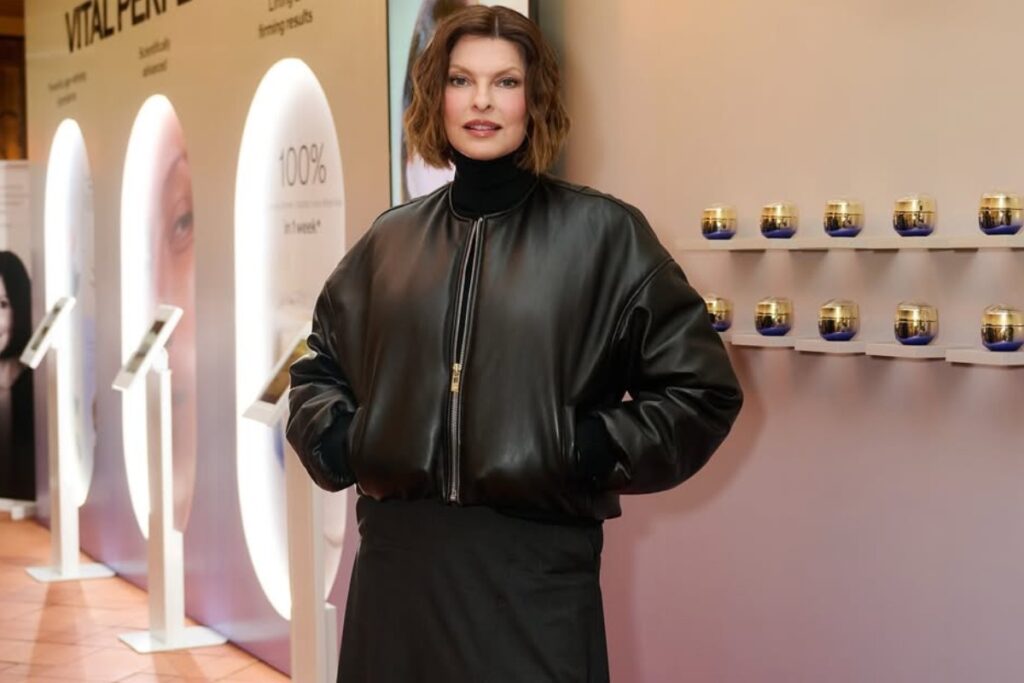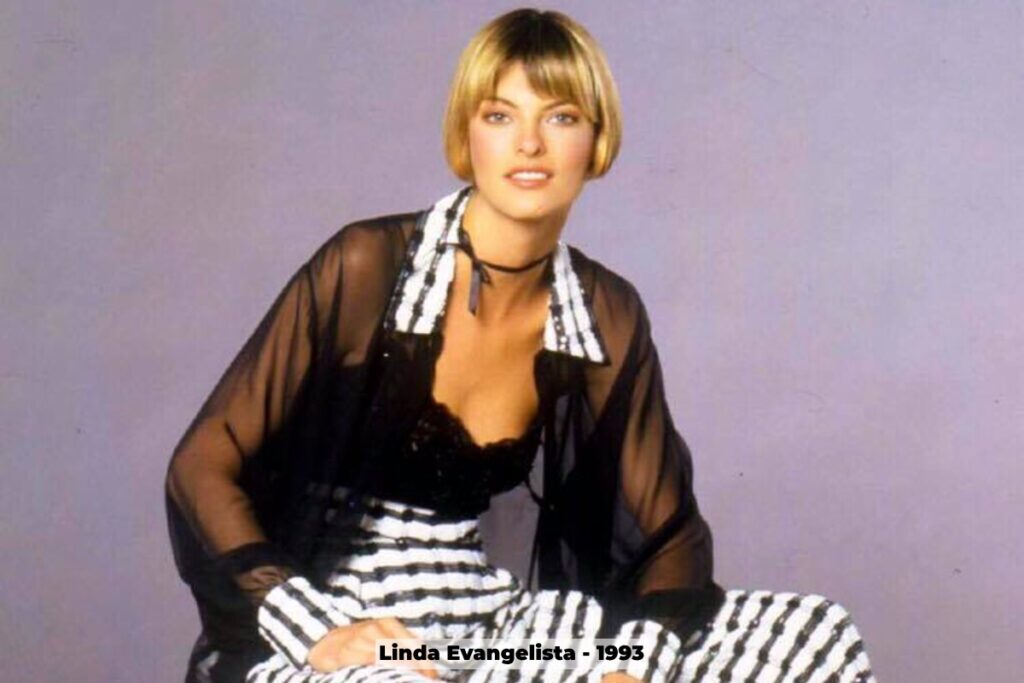
Linda Evangelista
Linda Evangelista didn’t just walk the runway—she owned it. With her striking features, ever-changing looks, and unmatched versatility, she became one of the most influential supermodels of all time.
Rising to fame in the mid-1980s, she quickly worked her way to the top, collaborating with the world’s most prestigious designers, photographers, and brands.
Evangelista’s fearless approach to modeling set her apart. She became known for her willingness to transform her appearance, pioneering the era of dramatic hair changes that kept the industry captivated.
Her bold choices made her the muse of Steven Meisel, the face of countless magazine covers, and a dominant presence on the catwalk.
Beyond the glamour, Evangelista played a key role in shaping the fashion industry. She helped elevate models to celebrity status, proving that they were more than just faces on magazine covers.
Her career reflects dedication, reinvention, and resilience, showing that true supermodels don’t just follow trends—they create them.
Early Life
Linda Evangelista’s journey from a small-town girl to a global fashion icon is a tale of resilience, transformation, and unparalleled influence.
Born on May 10, 1965, in St. Catharines, Ontario, Canada, she was raised in a strict, working-class Catholic family.
Her parents, Marisa and Tomaso Evangelista, had emigrated from Italy, seeking a better future. Her father, a dedicated General Motors employee, and her mother, a meticulous bookkeeper, instilled in her a strong work ethic that would later define her extraordinary career.
Even as a young girl, Linda Evangelista showed a keen interest in fashion. At just 12 years old, she enrolled in a self-improvement course at a modeling school, where she learned the art of poise and etiquette.
By her teenage years, she was modeling locally, but it was her participation in the 1981 Miss Teen Niagara beauty pageant that set her future in motion.
Though she didn’t win, she captured the attention of a scout from Elite Model Management, a moment that changed everything.
At 16, Evangelista took a leap of faith and traveled to Japan for a modeling opportunity. However, an uncomfortable experience involving nudity during a shoot nearly made her abandon the industry entirely. She returned home, disillusioned, and took a two-year hiatus. But fate had other plans.
At 18, she decided to give modeling another shot and moved to New York City, where she signed with Elite Model Management in 1984.
Linda Evangelista’s rise to fame was nothing short of meteoric. In 1988, photographer Peter Lindbergh suggested she cut her long hair into a short, boyish crop—a bold move that redefined her career.
The dramatic transformation made headlines and cemented her status as a chameleon of the fashion industry.
Evangelista wasn’t just another model; she was a muse. Her collaboration with legendary photographer Steven Meisel became one of the most celebrated partnerships in fashion history, with her face gracing over 700 magazine covers.
How Linda Evangelista’s Career Unfolded
Linda Evangelista is more than just a model—she is an icon, a muse, and a force that reshaped the fashion industry.
From her rise in the mid-1980s through the 1990s, Evangelista reigned as one of the five original supermodels, alongside Christy Turlington, Naomi Campbell, Claudia Schiffer, and Cindy Crawford.
Her unwavering commitment to her craft led to one of the most famous quotes in fashion history:
“We don’t wake up for less than $10,000 a day.”
As the following sections reveal, Evangelista’s career is a testament to reinvention, resilience, and unparalleled success—solidifying her legacy as one of fashion’s most enduring icons.
The Early Days: The Path to Fashion’s Global Runways (1984–1987)
In 1984, a young and ambitious Linda Evangelista left her hometown and moved to New York City after signing with Elite Model Management.
There, she caught the eye of John Casablancas, who compared her striking looks to supermodel Joan Severance.
Recognizing her potential, Elite swiftly relocated her to Paris, launching her international high-fashion career at just 19 years old.
That same year, Linda Evangelista graced the cover of L’Officiel, marking the beginning of a prolific career.
Soon, she became a fixture in the pages of Vogue, Harper’s Bazaar, Cosmopolitan, Elle, Marie Claire, and countless other top-tier publications.
With over 700 covers worldwide, she established herself as a true icon in the fashion world.
In 1985, she began working with Karl Lagerfeld, the legendary head designer of Chanel, who famously praised her professionalism.
Evangelista quickly became a muse for Lagerfeld and later for Gianni Versace, debuting in a Versace ad campaign in 1987.
Her presence extended beyond the runway, representing luxury brands such as Valentino, Dolce & Gabbana, Ralph Lauren, and Yves Saint Laurent.
But her appeal wasn’t limited to fashion—corporate giants like Visa, American Express, and Pizza Hut also sought her star power.
A pivotal moment in her career came in 1986 when she met photographer Steven Meisel. Their collaboration sparked a lifelong partnership, with Meisel often calling her his muse.
By 1987, Linda Evangelista had become a household name, appearing in Revlon’s “The Most Unforgettable Women in the World” campaign, shot by the legendary Richard Avedon.
The Birth of a Supermodel (1988–1992)
In 1988, Linda Evangelista took a bold step that would forever change her career. Encouraged by Peter Lindbergh, she chopped her long hair into a short gamine cut. Initially, the industry rejected the look, canceling her from 16 fashion shows.
But by 1989, her haircut—dubbed “The Linda”—became the season’s hottest trend, even inspiring wigs named after her.
As one of the original “supermodels,” Evangelista joined Naomi Campbell and Christy Turlington to form “The Trinity”—a trio of models who transcended fashion to become global celebrities.
In 1990, she graced the iconic British Vogue cover that defined the supermodel era. This cover caught the attention of George Michael, who cast her in his legendary “Freedom! ’90” music video, further cementing her pop culture status.
That same year, Linda Evangelista made headlines with her now-famous declaration: “We don’t wake up for less than $10,000 a day.”
The quote became one of the most famous statements in modeling history, symbolizing the era’s glamour and exclusivity.
Known for her ever-evolving style, Evangelista continuously reinvented herself. In 1990, she shocked the industry by dying her hair platinum blonde, only to transform again with a fiery “technicolor red” shade months later.
Her chameleon-like ability to adapt set her apart, drawing comparisons to Hollywood icons like Sophia Loren and Elizabeth Taylor.
By 1991, rumors swirled that Lanvin paid her a record-breaking $20,000 to walk a single runway show. That year, she also walked for Anna Sui, waiving her fee in support of the designer’s debut.
Meanwhile, Time magazine crowned her “the world’s star model,” further solidifying her status at the top of the industry.
In 1992, her career reached new heights when she appeared on the cover of Vogue’s 100th anniversary issue—the magazine’s highest-selling edition to date.
She starred in George Michael’s “Too Funky” music video and graced the covers of Harper’s Bazaar and Flare, setting beauty trends with her signature thin eyebrows.
That year, she was even immortalized in RuPaul’s hit song “Supermodel (You Better Work).”
Evolution, Retirement, and the Comeback (1993–Present)
By the mid-1990s, Linda Evangelista continued to dominate fashion. She toured Australia with Claudia Schiffer in 1993, starred in the film Prêt-à-Porter, and landed a lucrative Clairol contract worth over $5 million. In 1996, she appeared in Vogue Taiwan’s and Vogue Korea’s inaugural issues and secured a $7.75 million deal with Yardley of London.

However, in 1998, she shocked the fashion world by announcing her retirement. She retreated to the French Riviera, stepping away from the spotlight for nearly two years.
But in 2001, Linda Evangelista made a triumphant return. She landed the cover of Vogue’s September issue and revived the Blackglama “What Becomes a Legend Most?” campaign.
Over the next decade, she reclaimed her supermodel status, starring in campaigns for Versace, Chanel, Fendi, and L’Oréal.
Her runway comeback was just as spectacular—she closed Chanel’s 2003 haute couture show in a breathtaking white wedding gown.
In 2006, she made history as the first model in over a year to land Vogue’s cover. She continued her reign as the face of L’Oréal Paris and appeared at Cannes alongside Aishwarya Rai.
By 2008, Vanity Fair featured her in a supermodel retrospective titled “A League of Their Own.”
The 2010s saw Linda Evangelista embracing new roles in the fashion industry. In 2016, she stepped behind the camera as a stylist for Harper’s Bazaar and became the Creative Director of Erasa Skincare.
In 2023, she joined Cindy Crawford, Naomi Campbell, and Christy Turlington for Apple TV+’s docuseries The Super Models, revisiting the era she helped define.
Linda Evangelista’s Enduring Influence
Few names in fashion evoke the same level of admiration and influence as Linda Evangelista. Decades after her legendary statement about not getting out of bed for less than $10,000 a day, the quote continues to be referenced in pop culture.
Even in 2017, media outlets revisited her words, proving their enduring impact. Evangelista herself once noted how her phrase evolved, recalling a scene from Mr. & Mrs. Smith where Brad Pitt joked about not getting out of bed for less than half a million dollars. “That’s my line!” she quipped. “Only now, it’s a half-million and a man saying it.”
Evangelista’s iconic status has transcended fashion, extending into home decor and luxury branding. T-shirts bearing her famed $10,000 quote have been sold globally, and an embroidered pillow with the phrase became a must-have collector’s item.
The G Hotel in Galway, Ireland, even named its presidential suite in her honor, with interiors designed by Philip Treacy.
The Art and Auction Legacy of Linda Evangelista
The influence of Linda Evangelista is not confined to the runway—it has extended into the world of fine art.
A photograph of her from the September 1991 Vogue spread titled “Wild At Heart,” shot by Peter Lindbergh, became an iconic representation of fashion photography.
One of its most famous images, The Wild Ones, was auctioned at Sotheby’s for over $30,000.
The value of Evangelista’s presence in photography has only increased over time. In October 2012, a striking image of her and Kristen McMenamy, captured by Steven Meisel for Vogue‘s October 1992 issue, fetched $86,500 at auction.
Another defining image, a 1988 Lindbergh photograph featuring Evangelista alongside five other supermodels, was sold for $118,462 at Sotheby’s in 2016.
Additionally, Linda Kissing Linda, a 1996 photograph from a Kenar campaign, was selected by the Guggenheim Museum as a representation of androgyny in fashion.
A Beauty Icon Who Inspired Generations
Beyond her work in front of the camera, Linda Evangelista has left an indelible mark on beauty and fashion.
She has influenced some of the world’s most famous celebrities, from Victoria Beckham and Martha Stewart to models Candice Swanepoel, Kendall Jenner, Kylie Bax, Elsa Benítez, and Angie Harmon.
Even music icon Rihanna has cited Evangelista as a beauty inspiration.
Praise from Fashion’s Elite
The greatest minds in fashion have long celebrated Linda Evangelista as the ultimate model. Philip Treacy once declared, “Linda is the ultimate model of the past 50 years.”
Karl Lagerfeld echoed this sentiment, calling her “the most famous of all” and “the best model in the world.” Designer Stefano Gabbana stated unequivocally, “Linda is the model.
If you talk about models of the sixties and seventies, the first name is Veruschka. In the eighties and nineties, it’s Linda.”
David Bonnouvrier, co-founder of DNA Model Management, affirmed, “Linda is the model of all time, to its strictest definition.
She could be out of a Cecil Beaton picture, she could be out of a Guy Bourdin picture.”
The legendary Franca Sozzani, former editor-in-chief of Vogue Italia, once admitted that she would receive letters from readers worried about what would happen to the magazine if Evangelista were ever unavailable.
“It was all about Linda Evangelista. Her face had the most possibilities.”
The Muse Who Defined an Era
Steven Meisel, widely regarded as Evangelista’s most dedicated collaborator, has often called her his muse, stating that she is “extraordinarily photogenic.”
The impact of her presence was felt across the industry, with John Galliano confessing, “Inspiration hasn’t been the same without her. She is an enormous influence on all photographers and stylists.”
Kevyn Aucoin, the legendary makeup artist, once wrote, “I first worked with Linda in the early eighties and have yet to meet another model who was more involved in every aspect of her work.
She knew what was best for her hair, makeup, styling, and lighting—and Linda was always right.” Fashion stylist Paul Cavaco agreed, calling her “the greatest collaborator of all time.”
The Supermodel’s Supermodel
Linda Evangelista wasn’t just a supermodel—she was the supermodel. Marcus Chang of T: The New York Times Style Magazine dubbed her “the supermodel’s supermodel.”
Shane Watson of The Evening Standard credited Evangelista with revolutionizing the modeling industry, writing, “Of all the supermodels, Linda was most responsible for elevating the job into an art form, pushing up the fees, piling on the expectations, and ensuring that by the end of the Eighties, the world of the top model had become as lucrative, glamorous, and shrouded in enigma as that of the Hollywood star.”
Linda Evangelista’s impact on fashion, photography, and culture is immeasurable. Even decades after her peak, her legacy continues to shape the industry, proving that true icons never fade—they only become more legendary.
Linda Evangelista: A Supermodel with a Cause
Beyond the glamorous world of high fashion, Linda Evangelista has long been a force for change, using her influence to champion causes close to her heart.
Known for her timeless beauty and legendary career, Evangelista has dedicated herself to activism, particularly in the fight against HIV/AIDS and breast cancer.
Her commitment to these causes became evident when she became one of the iconic faces of MAC’s Viva Glam campaign, a groundbreaking initiative that raised millions for the MAC AIDS Fund.
She didn’t stop there—Evangelista actively supported the Elton John AIDS Foundation and passionately advocated for LGBTQ+ rights, lending her voice to those in need of visibility and support.
In October 2013, she took center stage as the host of amfAR’s Inaugural Inspiration Gala in Rio de Janeiro, Brazil, an event dedicated to raising funds for AIDS research.
But Linda Evangelista’s impact isn’t just about advocacy—it’s also about recognition. Her contributions to the fashion world earned her the Lifetime Achievement Award at VH1’s Fashion Awards in 1996, presented by none other than Vogue’s iconic editor-in-chief, Anna Wintour.
A few years later, in June 2003, Evangelista was honored with a star on Canada’s Walk of Fame, cementing her status as one of the country’s most legendary figures.
Her influence on fashion was further solidified in 2005 when she was named a World Fashion Icon by the Women’s World Awards in Leipzig, Germany.
And in 2008, fans confirmed what the industry already knew—Linda Evangelista was more than a supermodel, she was a legend.
In a poll conducted by CBC Television’s Fashion File, viewers crowned her “The Greatest Supermodel of All Time”—a title befitting the woman who helped define an era.
From the runways of Paris to the frontlines of social change, Linda Evangelista has proven time and time again that true beauty lies in using one’s platform to make a difference.
Linda Evangelista’s Personal Life
Beneath the glamour of her supermodel reign, Linda Evangelista has lived a life marked by love, heartbreak, legal battles, and personal struggles—each chapter shaping her into the resilient icon she is today.
Love, Loss, and Relationships
Evangelista’s journey through love began in 1987 when she married Gérald Marie, the powerful head of Elite Model Management’s Paris office.
Their marriage lasted six years before ending in 1993. Shortly after, fate led her to actor Kyle MacLachlan, whom she met during a high-profile Barneys New York photoshoot in 1992.
Their whirlwind romance resulted in an engagement in 1995, but by 1998, their love story had come to an end.
Seeking love once more, Evangelista found companionship with French footballer Fabien Barthez.
Their relationship, however, was met with heartbreak when she suffered a miscarriage six months into her pregnancy. The couple parted ways in 2000, briefly reunited in 2001, but ultimately separated for good in 2002.
The High-Profile Child Support Battle
In October 2006, Evangelista welcomed her son into the world but remained tight-lipped about the identity of his father.
Speculation swirled, especially when she graced the cover of Vogue while pregnant in August 2006. The mystery was finally revealed in June 2011, when Evangelista filed court papers disclosing that her son’s father was none other than François-Henri Pinault, the billionaire businessman who later married actress Salma Hayek.
A legal battle erupted when Evangelista sought $46,000 per month in child support, a figure that, if granted, would have been one of the highest in family court history.
The courtroom drama unfolded in May 2012, with Evangelista’s lawyers arguing that Pinault had never contributed financially to his son’s upbringing.
But just days into the trial, on May 7, 2012, both parties reached an out-of-court settlement, putting an end to the public spectacle.
Faith and Personal Beliefs
Despite her fast-paced career and high-profile relationships, Evangelista remained deeply spiritual.
In a 1997 interview, she identified as a practicing Roman Catholic and named the Bible as her favorite book—a grounding force amidst her ever-evolving life.
The Devastating Impact of a Cosmetic Procedure
In September 2021, Evangelista made a shocking revelation about why she had disappeared from the public eye.
Five years earlier, she had undergone CoolSculpting, a non-invasive fat reduction procedure, only to suffer a rare and devastating side effect: paradoxical adipose hyperplasia (PAH)—a condition that caused the treated areas to enlarge rather than shrink.
The experience left her emotionally and physically scarred, forcing her into seclusion.
Taking legal action against Zeltiq Aesthetics, the company behind CoolSculpting, Evangelista sought $50 million in damages for lost income and emotional distress. By July 2022, she reached a settlement, marking the end of a painful chapter.
Fighting for Her Life: The Battle with Breast Cancer
As if her challenges weren’t already immense, Linda Evangelista revealed in 2023 that she had been fighting an even greater battle—breast cancer.
Diagnosed in December 2018, she faced the disease with unwavering determination, undergoing chemotherapy and a bilateral mastectomy.
Though the ordeal seemed to be behind her, the cancer returned in 2022, this time attacking her pectoral muscle. Once again, Evangelista endured chemotherapy, refusing to let the disease define her.
Linda Evangelista: From the Runway to the Screen
Beyond her reign as a supermodel, Linda Evangelista carved a space for herself in film, television, and music videos, leaving an indelible mark on pop culture.
Whether gracing the silver screen or starring in some of the most iconic music videos of all time, Evangelista’s presence has been nothing short of legendary.
A Cinematic and Television Journey
Evangelista’s first major on-screen appearance came in 1991 with the documentary Models: The Film, which provided an insider’s look into the high-fashion world.
She continued to captivate audiences with appearances in 1995’s Catwalk and Unzipped, both documentary films that chronicled the glitz, glamour, and behind-the-scenes chaos of the modeling industry.
Her influence extended beyond the fashion circuit. She made an appearance—albeit uncredited—in 1994’s Prêt-à-Porter, a satirical comedy-drama set in the world of haute couture.
As the years passed, Evangelista remained a fixture in fashion documentaries, proving that her impact transcended decades.
She featured in 2013’s Mademoiselle C and Mode als Religion (Fashion as a Religion), exploring the artistry and cultural significance of fashion.
That same year, she took part in George Michael’s Freedom documentary, celebrating his life and career.
In 2023, Evangelista took on a new role—executive producer—for The Super Models, an Apple TV+ docuseries that chronicled the rise of the original ‘90s supermodels, including Naomi Campbell, Cindy Crawford, and Christy Turlington.
This series, which gave fans an intimate look at their journey, further cemented Evangelista’s legacy as one of the greatest models in history.
Music Video Icon: A George Michael Muse
Few moments in pop culture are as timeless as George Michael’s 1990 hit “Freedom! ‘90”—and Linda Evangelista was at the heart of it.
The video, which featured Evangelista alongside Naomi Campbell, Cindy Crawford, Christy Turlington, and Tatjana Patitz, was a revolution in music and fashion, replacing traditional performers with supermodels lip-syncing Michael’s lyrics.
Two years later, Evangelista reunited with George Michael for his 1992 hit “Too Funky”, a fashion-infused spectacle that further showcased her dominant on-screen presence.
Final Note about Linda Evangelista
Linda Evangelista is more than just a supermodel—she is a fashion icon, cultural phenomenon, and a trailblazer whose impact continues to shape the industry.
From dominating the runways of the ‘80s and ‘90s to redefining the role of a model in pop culture, she has remained an enduring force in fashion, entertainment, and activism.
Beyond her record-breaking career, Evangelista’s influence extends to philanthropy, advocacy, and resilience.
Her unwavering support for HIV/AIDS research, breast cancer awareness, and LGBTQ+ rights showcases her commitment to using her platform for meaningful change.
Even in the face of personal struggles, legal battles, and health challenges, she has emerged stronger—her courage and transparency inspiring generations.
As the ultimate supermodel, Evangelista set new standards for beauty, professionalism, and artistry.
Whether gracing Vogue covers, starring in legendary music videos, or shaping the next era of fashion through storytelling and production, her legacy is one of reinvention and influence.
Decades after she first stepped onto the scene, Linda Evangelista’s name remains synonymous with elegance, power, and transformation—a true testament to her unparalleled legacy in the world of fashion and beyond. She lives a life of triumph, trials, and resilience.
At Facts and Tips, we strive for accuracy and honesty.
If you notice any errors, whether factual, editorial, or outdated information, please don't hesitate to contact us.
Found this Story about Linda Evangelista informative and useful? Share it with your friends and colleagues—they might find it helpful too!






